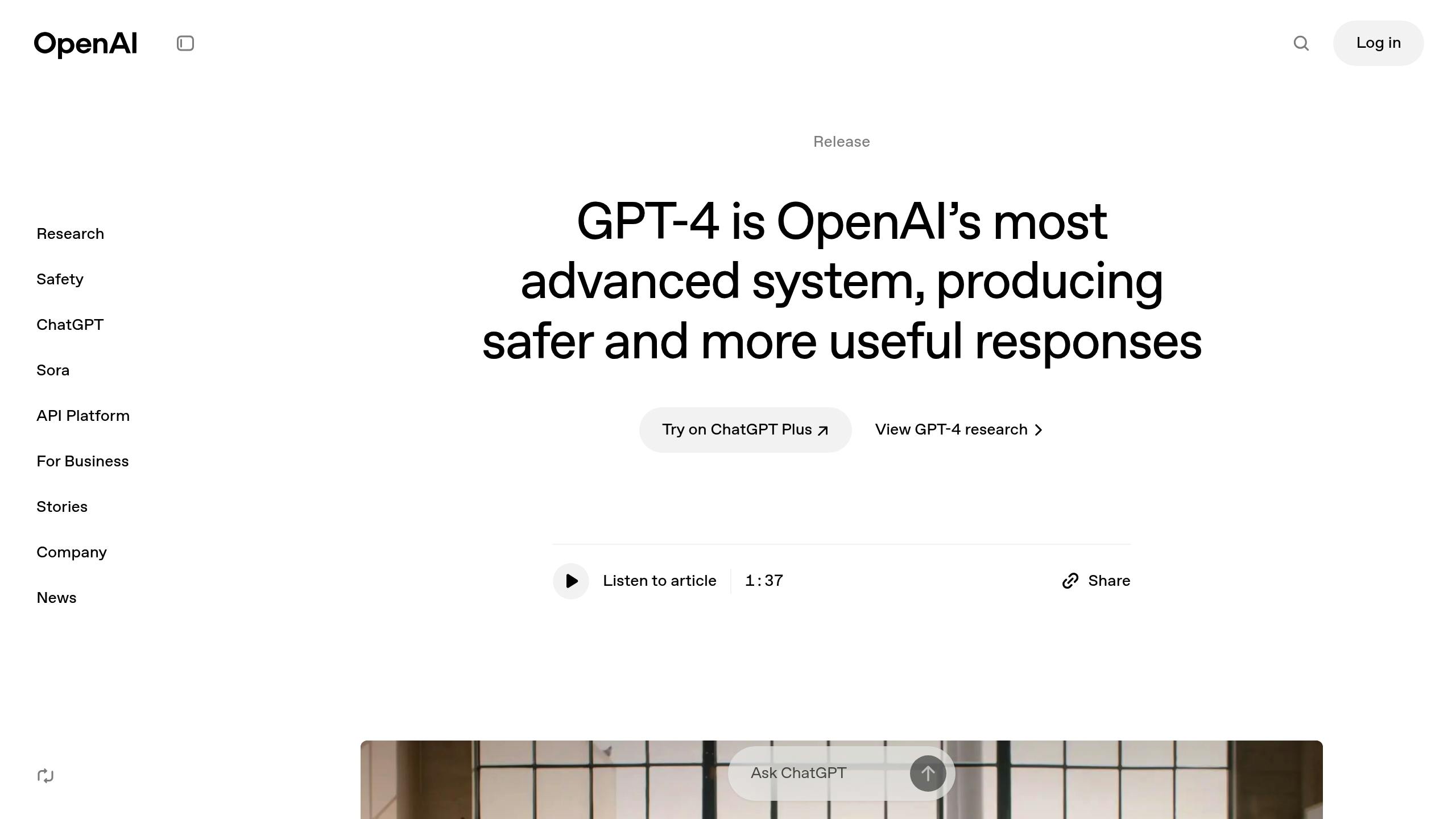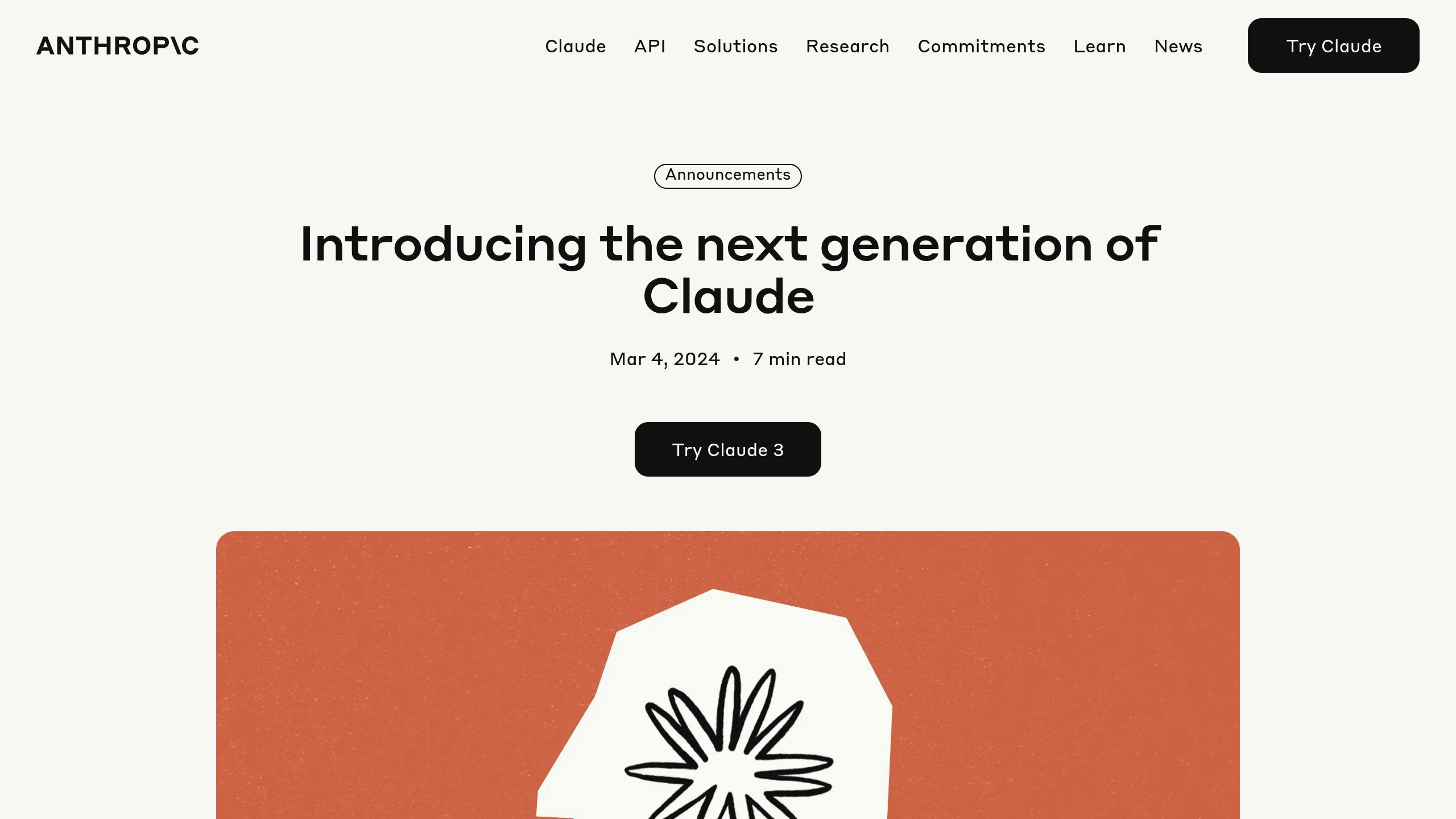
GPT-4 vs Claude: Which AI Model Fits Your Needs?
GPT-4 vs Claude: Which AI Model Fits Your Needs?
Looking for the right AI model? Here's the quick answer:
If you need versatility for coding, creative writing, or technical problem-solving, GPT-4 is your model. For ethical, safety-focused tasks like content moderation or customer support, go with Claude.
Key Highlights:
- GPT-4: Best for creative projects, advanced coding, and technical tasks. Handles text and image inputs.
- Claude: Focused on safe, ethical outputs with a larger context window (up to 200,000 tokens).
Quick Comparison:
| Feature | GPT-4 | Claude |
|---|---|---|
| Core Focus | Versatility | Ethical alignment & safety |
| Inputs | Text & images | Text only |
| Context Window | Up to 128,000 tokens | Up to 200,000 tokens |
| Best For | Creative, technical work | Safety, customer support |
| Pricing | Pay-per-token | Tiered pricing |
Which to choose?
- Pick GPT-4 for creative writing, coding, or technical analysis.
- Go with Claude for ethical, safety-critical tasks like healthcare or content moderation.
Pricing Tip: GPT-4’s pay-as-you-go model offers flexibility, while Claude’s tiered pricing suits steady, high-volume usage.
Core Differences: GPT-4 vs Claude

Base Capabilities
GPT-4 is designed to handle both text and images, thanks to its multi-modal Transformer architecture. This allows it to tackle a variety of tasks and even be fine-tuned for specific needs. On the other hand, Claude is more focused on generating safe and ethical outputs, guided by built-in contextual safeguards.
Here's a breakdown of their core capabilities:
| Capability | GPT-4 | Claude |
|---|---|---|
| Input Processing | Multi-modal (text and images) | Primarily text-based |
| Context Handling | Extended context retention | Strong contextual alignment |
| Architectural Focus | Broad versatility | Safety and ethical focus |
| Response Generation | Fluent and creative | Cautious and precise |
These differences in design shape their strengths and influence how they perform in various tasks.
Task Performance
The way these models are built directly impacts how they perform in practical applications. GPT-4 shines in technical and creative tasks, while Claude is better suited for situations where accuracy and responsible outputs are key.
GPT-4 is particularly strong in solving technical problems like coding and math. It also stands out in creative tasks, offering a wide range of writing styles and tones without losing coherence.
Claude, however, focuses on producing responses that are accurate and considerate. This makes it ideal for tasks where misinformation needs to be avoided, such as customer support. For example, Claude often delivers more empathetic and context-aware replies, while GPT-4 is a go-to for handling complex or technical queries.
Claude 3 Review and Real-World Tests: Does It Outperform ...

::: @iframe https://www.youtube.com/embed/tmEfSWraMUE :::
Speed and Accuracy Tests
Let's dive into how these models perform when it comes to speed and accuracy.
Memory and Text Length Limits
The size of the context window determines how much content a model can handle in one go. Here's a comparison:
| Model Version | Context Window |
|---|---|
| Claude 3 | 200,000 tokens |
| GPT-4 (Standard) | 8,192 tokens |
| GPT-4 Turbo | 128,000 tokens |
This means Claude 3 can process much longer documents in a single session compared to the standard GPT-4.
Content Generation Skills
GPT-4 is known for producing well-structured, engaging text, even over longer passages. On the other hand, Claude stands out when it comes to creating precise content for tasks like:
- Legal analysis
- Academic research
Each model has its strengths, depending on the type of content you need.
Technical Problem-Solving
When it comes to tackling technical challenges, GPT-4 is quick and efficient, particularly for the following tasks:
| Task Type | Speed | Use Case |
|---|---|---|
| Live Coding Support | Fast | Interactive debugging |
| Customer Support | Standard | Chat assistance |
| Technical Analysis | Fast | System troubleshooting |
Claude, with its ability to handle larger context windows, is well-suited for detailed technical discussions and complex problem-solving scenarios.
When to Use Each Model
Understanding the strengths of each model can help you choose the right one for specific tasks. Here's a breakdown based on their key capabilities:
Task-Specific Comparison
The table below highlights which model works best for various tasks and why:
| Task Category | Best Model | Key Strengths |
|---|---|---|
| Content Moderation | Claude | Ethical focus, effective bias detection |
| Creative Writing | GPT-4 | Wide range of writing styles |
| Technical Documentation | Claude | Clear explanations, factual accuracy |
| Code Development | GPT-4 | Advanced debugging, multilingual support |
| Healthcare Applications | Claude | Careful, ethical responses |
| Marketing Content | GPT-4 | Engaging storytelling, flexible tone |
| Legal Analysis | GPT-4 | Detailed reasoning and in-depth analysis |
| Business Automation | GPT-4 | Broad integration capabilities |
Common Usage Examples
These strengths translate into practical applications across industries:
Healthcare and Research
Claude's cautious nature and ability to handle medical documentation make it a strong choice for healthcare tasks, such as patient care records and medical research.
Creative Industries
For marketing campaigns, storytelling, or generating diverse content formats, GPT-4 stands out for its versatility and creativity.
Technical Implementation
When it comes to programming, GPT-4 offers depth in writing code, debugging, and developing detailed technical specifications.
Ethical Considerations
Claude is particularly suited for tasks requiring a strong ethical focus, such as content moderation, policy analysis, and creating educational materials.
Choosing the Right Model
To decide which model to use, consider the following factors:
- The complexity of your project
- The level of creativity required
- Ethical requirements
- Technical needs
- The size of the context window needed
Pricing and Access
Cost Structure
Here’s an overview of the pricing models as of April 2025:
-
GPT-4 Turbo follows a pay-as-you-go system:
- Input requests: $0.01 per 1,000 tokens
- Output generation: $0.03 per 1,000 tokens
-
Claude offers tiered pricing:
- Claude Instant: $1.63 per million tokens
- Claude 2 (standard processing): $8.00 per million tokens
- Claude 2 (expedited processing): $24.00 per million tokens
For businesses, these costs can notably affect overall expenses. For instance, using Claude 2 at standard processing rates costs $8.00 per million tokens. It’s important to weigh usage volumes and application requirements carefully to align costs with performance needs.
This breakdown helps evaluate which platform fits your budget and operational goals.
Conclusion
Main Points
Choosing between GPT-4 and Claude ultimately depends on what you need. GPT-4 stands out for handling complex questions, keeping extended context, and excelling in tasks like creative writing and technical problem-solving. Its ability to grasp subtle nuances and interpret ambiguous inputs makes it a strong contender for intricate projects.
Claude, on the other hand, prioritizes ethical safety. It’s designed for scenarios where responsible AI use and careful content moderation are critical. This makes it a great fit for customer-facing roles and situations where safety is a top concern.
Here’s a quick comparison of their key differences:
| Aspect | GPT-4 | Claude |
|---|---|---|
| Core Strength | Broad capabilities and technical depth | Ethical focus and safety |
| Best Use Cases | Writing, coding, data analysis | Customer support, content moderation |
| Response Speed | Faster for basic tasks | Slightly slower but prioritizes safety |
| Cost Structure | Pay-per-token model | Tiered pricing system |
| Technical Depth | Strong reasoning skills | Less suited for technical applications |
This table highlights their strengths, helping you decide which model fits your needs.
Selection Guide
Based on the differences, here are some recommendations for choosing the right model:
Pick GPT-4 if you need:
- Content creation or creative problem-solving
- Advanced technical assistance
- Flexibility for various applications
- Fast responses
- Handling conversations with complex context
Go with Claude if you prioritize:
- Ethical AI with safe, controlled outputs
- Reliable content moderation
- Easy, intuitive interactions
- Clear communication for customer-facing tasks
Pricing is another factor to consider. GPT-4’s pay-as-you-go model is flexible for varying usage, while Claude’s tiered pricing may suit businesses with steady usage and a focus on ethical standards.
"Claude is ideal for applications requiring high ethical alignment and caution, while GPT-4 shines in tasks demanding creativity, adaptability, and technical depth. Enterprises must align their choice with their operational priorities." [1]
Both models are evolving, so the best choice depends on your specific needs, budget, and ethical goals.